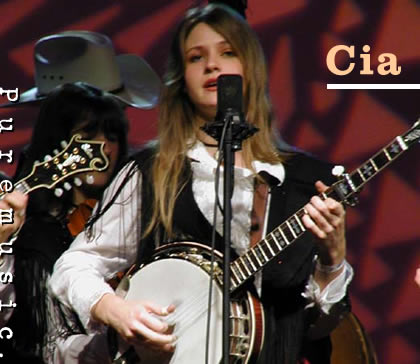
A Conversation with Sandy Cherryholmes (continued)
PM: Okay, so some of us are guitar players, and we can share that, or some bass, or this or that. But when it comes to something like banjo--I know you're a clawhammer banjo player--
SC: Uh-huh.
PM: --but when it comes to something like bluegrass banjo, I mean, that's something kind of hard to pick up on your own. Did you know that bluegrass style of picking, too? Did you teach Cia that?
SC: Absolutely not. What was strange is that Cia started as a guitar player. And when we'd been together about a year, Jere and I got to talking and saying, "There are promoters hiring us, and we're a bluegrass band, and we don't have a banjo."
PM: [laughs] That'll never do.
SC: Yeah. We had two mandolin players, two guitar players, bass, and we had no banjo. And we thought, "Our career is not going to be very long without a banjo."
PM: [laughs]
SC: And so then we looked at the kids and we wondered who would do it? Well, I might have been able to study it and pick it up, but I had so many other things I was trying to do. And so we looked at the kids and tried to evaluate who would be someone who would work hard and get it down, and we decided Cia. She had the ability to really apply herself. She was disappointed when her dad told her, "I need you to switch to banjo," because she had bought her new guitar, and she'd practiced the guitar.
PM: She was a hot flat picker.
SC: She was a good flat picker. She was really good. She had taught herself how to do that. And we went to festivals in that November--I think it was November of about 2000--with two banjos. We picked up a bluegrass banjo, and we picked up a clawhammer banjo, and decided that between the two of us, we could both learn enough banjo to make it look like we had a bluegrass band.
So I learned to play clawhammer, and she learned to play three-finger style. She just listened to recordings and tried to get ideas on how to set her fingers, and went to jams, and asked people to show her. And then I did the same, got together with a clawhammer friend of mine and said, "Show me how to play this thing." And we very quickly tried to work things out and add them to the show so that we could continue on with some sort of sense of--it would look like we had some banjos going, anyway.
PM: Wow. Yeah, because you've got to have somebody to show you some of that stuff, seems to me. I'm a pretty good finger picker on the guitar, but when it came to starting to disentangle the bluegrass picking, I thought, "I need somebody to show me some of these rolls. I don't think I'm doing this right." [laughs] And so now I've had a couple of lessons, and now I'm starting to understand how to roll around on that instrument just a little bit. But it's kind of a bizarre thing to pick up at the beginning, I think.
SC: It is. And so much of it Cia got just from listening. She would listen to recordings. She'd slow them down and try to hear the individual notes.
PM: Ah.
SC: And so at first she didn't have some of the fingering right, but she'd have the notes right, because she could hear the notes in the record. And she would play them, but then she'd realize, "Well, the fingering on this is really awkward." I know once we were opening for Del McCoury. And we kept telling her, "Go up to Robbie and ask him about that lick." And she was really nervous. And then she asked him, "How do I--am I doing this right?" And she played it for him and he said, "You got the notes right, but your fingers are in the wrong position." Then he showed her. We didn't really have a concept of those chords that you could do everything from.
PM: Right.
SC: If you know the one main chord, you can do everything from there. And he showed her a couple little things to correct it, and then she went home and worked on it some more, and she just built it up. She started playing the first of December, and she was on stage doing her first concert with us middle of January.
PM: Unbelievable. Well, that's the fearlessness of kids, too.
SC: Yes.
PM: They just say, "What? I can tear this apart. There's nothing to it."
[laughter]
SC: Right, right.
PM: It's a beautiful thing. It's like the way they learn languages, too. They just start talking.
SC: And they're uninhibited. I knew that at that age, even if they messed up, everyone was just going to be so wild about it and think they were great. You know, when you're older and you mess up, people think, "Ah, this stupid person can't do that anyway."
PM: [laughs] Yeah, that's right.
SC: But when you're young they think everything you do is wonderful.
print (pdf) listen to clips puremusic home